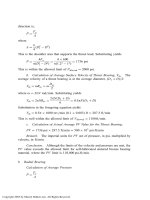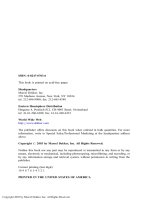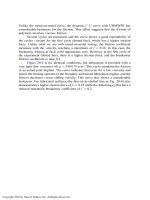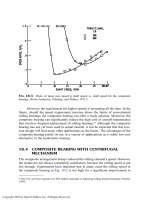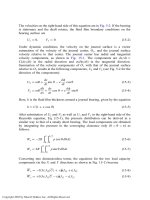Bearing Design in Machinery Episode 3 Part 6 docx
Bạn đang xem bản rút gọn của tài liệu. Xem và tải ngay bản đầy đủ của tài liệu tại đây (472.61 KB, 18 trang )
catastrophic failure, because the tough core minimizes undesired crack propaga-
tion. In addition, M50NiL can operate at higher speeds, is more wear resistant,
has higher tensile stress, higher fracture toughness, and lower boundary lubrica-
tion friction than AISI M-50.
13.19.2.3 DD400
For instrument ball bearings, corrosion resistance is very important. A stainless
steel DD400 has been developed for precision miniature rolling bearings and
small instrument rolling bearings. Corrosion resistance, combined with adequate
hardness, has been achieved by increasing the quantity of dissolved chromium in
the material. However, corrosion-resistant stainless steels have reduced fatigue
resistance, and they are applied only for light-duty bearings. The composition of
DD400 is 0.7% C, 13% Cr and it is martensitic stainless steel. DD400 replaced
AISI 440C (1% C, 17% Cr), which was used for similar applications. DD400
demonstrated better performance in comparison to AISI 440C in small bearings.
The most important advantages are: better surface finish of the races and rolling
elements, better damping of vibrations, and improved fatigue life. These
advantages are explained by the absence of large carbides in the heat-treated
material.
13.20 PROCESSES FOR MANUFACTURING
HIGH-PURITY STEEL
In addition to the chemical composition, the manufacturing process is very
important for improving fatigue resistance, particularly at high temperatures. For
critical applications, such as aircraft engines, there is a requirement for fatigue-
resistant materials with a high degree of purity. It was realized that there are
significant amount of impurities in the bearing rings and rolling elements, in the
form of nonmetal particles as well as microscopic bubbles from gas released into
the metal during solidification. In fact, these impurities have an adverse effect
equivalent to small cracks in the material. These microscopic cracks propagate
and cause early fatigue failure. Therefore, a lot of effort has been directed at
developing ultrahigh-purity steels for rolling bearings.
An advanced method for high purity steel is the vacuum induction method
(VIM). The melting furnace is inside a large vacuum chamber. The process uses
steel of high purity, and the required alloys are added from hoppers into the
vacuum chamber. A second method is the vacuum arc remelting (VAR) where a
consumable electrode is melted by an electrical arc in a vacuum chamber. The two
methods were combined and referred to as VIM-VAR. In the combined method,
the steel from the vacuum induction method is melted again by the vacuum arc
method. Successive vacuum arc remelting improves the bearing fatigue life.
Copyright 2003 by Marcel Dekker, Inc. All Rights Reserved.
Zaretzky (1997c) presented a detailed survey of the processing methods and
testing of bearing materials for aerospace applications.
13.21 CERAMIC MATERIALS FOR ROLLING
BEARINGS
There is an ever-increasing demand for better materials for rolling-element
bearings in order to increase the speed and service life of machinery. In addition,
machines are often exposed to corrosive environments and high temperatures that
cause steel bearings to fail. In a corrosive environment, the life of regular rolling
bearings made of steel is short. It would offer a huge economic benefit if an
alternate material could be developed that would increase the life of rolling
bearings.
For the last several decades, engineers have been searching for alternative
materials for the roller bearing. Although there are significant improvements in
the manufacturing processes and composition of steel bearings, scientists and
engineers have been continually investigating ceramics as the most promising
alternative materials.
In aviation, there is an ever-present need for the reduction of weight. It is
possible to reduce the size and weight of engines by operating at higher speeds. In
addition, weight reduction can be achieved if the engine efficiency can be
improved by operating at higher temperatures. Let us recall that according to
the basic principles of thermodynamics, the efficiency of the Carnot cycle is
proportional to the process temperature. Therefore, there is a need for materials
that can operate at high temperatures. It has been recognized that the bearings are
one bottleneck that limits the speed and temperature of jet engines. A lot of
research has been conducted in developing and testing ceramic materials that can
endure higher temperatures in comparison to steel. In addition, ceramics have a
low density, which is important in reducing the centrifugal force of the rolling
elements, a limiting factor of speed.
Initially, tests were conducted with rolling elements made of aluminum
oxide and silicon carbide. However, these tests indicated unacceptable early
catastrophic failure, particularly at high speeds and under heavy loads. Better
results were obtained later with silicon nitride, Si
3
N
4
.
The early manufacturing process for silicon nitride involved hot pressing.
The parts did not have a uniform structure and had many surface defects. The
parts required expensive finishing by diamond-coated tools. Moreover, the
finished parts did not have the required characteristics for using them in
rolling-element bearings.
Later, the development of a hot isostatically pressed (HIP) manufacturing
process significantly improved the structure of silicon nitride. The most important
Copyright 2003 by Marcel Dekker, Inc. All Rights Reserved.
properties of silicon nitride that make it suitable for rolling bearings is fatigue
resistance under rolling contact and relatively high fracture toughness. Silicon
nitride rolling elements showed a fatigue-failure mode by spalling, similar to
steel. In addition, silicon nitride proved to be wear resistant under the high contact
pressure of heavily loaded bearings. Most of the applications use silicon nitride
ceramic rolling elements in steel rings, referred to as hybrid ceramic bearings.
13.21.1 Hot Isostatic Pressing (HIP) Process
The introduction of the HIP process offered many advantages over the previous
hot-pressing process. The HIP process is done by applying a high pressure of
inert gases—argon, nitrogen, helium—or air at elevated temperatures to all grain
surfaces under a uniform temperature. Temperatures up to 2000
C (3630
F) and
pressures up to 207 MPa (30,000 psi) are used. The temperature and pressure are
accurately controlled. The term isostatic means that the static pressure of gas is
equal in all directions throughout the part.
This process is already widely used for shaping parts of ceramic powders as
well as other mixtures of metals and nonmetal powders. This process minimizes
surface defects and internal voids in the parts. The most important feature of this
process is that it results in strong bonds between the powder boundaries of similar
or dissimilar materials, which improve the characteristics of the parts for many
engineering applications.
In addition, the process reduces the cost of manufacturing because it forms
net or near-net shapes (close to final shape) from various powders, such as metal,
ceramic, and graphite. The cost is reduced because the parts are near the final
shape and less expensive machining is needed.
There are also important downsides to ceramics in rolling bearings. The
cost of manufacturing of ceramic parts is several times that of similar steel parts.
In rolling bearings, a major problem is that the higher elastic modulus and lower
Poisson ratios of silicon nitride result in higher contact stresses than for steel
bearings (see Hertz equations in Chapter 12). It is obvious that silicon nitride’s
higher elastic modulus and hardness result in a small contact area between the
balls and races. In turn, the maximum compression stress must be higher for
ceramic on steel and even more in ceramic on ceramic. The high contact stresses
can become critical and can cause failure of the ceramic rolling elements. This is
particularly critical in all-ceramic bearings, because ceramic-on-ceramic contact
results in higher stresses than ceramic balls on steel races.
13.21.2 Sil icon Nitride Bearings
The most widely used type is the hybrid bearing. It combines silicon nitride balls
with steel races. The second type is the all-ceramic bearing, often referred to as a
Copyright 2003 by Marcel Dekker, Inc. All Rights Reserved.
full-complement ceramic bearing. The two types benefit from the properties of
silicon nitride, which include low density, corrosion resistance, heat resistance,
and electrical resistance.
13.21.3 Hybrid B earings
The surfaces of steel races and ceramic rolling elements are compatible, in the
sense that they have relatively low adhesive wear. Ceramics sliding or rolling on
metals do not generate high adhesion force or microwelds at the asperity contacts.
The ceramic rolling elements have high electrical resistance, which is important
in electric motors and generators because they eliminate the problem of arcing in
steel bearings. However, the most important advantage of silicon nitride rolling
elements is their low density. The specific density of silicon nitride is 3.2, in
comparison to 7.8 for steel (about 40% of steel). The centrifugal forces are
proportional to the density of the rolling elements, and they become critical at
high speeds. Since pressed silicon nitride rolling elements are lighter, the
centrifugal forces are reduced.
Many experiments confirmed that hybrid bearings have a longer fatigue life
than do M-50 steel rolling elements. At very high speeds, the relative improve-
ment in the fatigue life of silicon nitride hybrid bearings is even higher, due to the
lower density, which reduces the centrifugal forces.
The silicon nitride is very hard and has exceptionally high compressive
strength, but the tensile strength is low. Low tensile strength is a major problem
for mounting the rings on steel shafts; but hybrid bearings have steel rings, so this
problem is eliminated.
Although research in hybrid bearings was conducted two decades earlier, it
is only since 1990 that they have been in a wide use for precision applications,
including machine tools. The high rigidity of silicon nitride balls was recognized
for its potential for improvement in precision and reduction of vibrations. This
property can be an advantage in high-speed rotors.
13.21.3.1 Fatigue Life of Hybrid Bearings
There is already evidence that hybrid bearings made of silicone nitride balls and
steel rings have much longer fatigue life than do steel bearings of similar
geometry. Examples of research work are by Hosang (1987) and Chiu (1995).
The major disadvantage of hybrid bearings is their high cost.
However, the advantages of the hybrid bearing are expected to outweigh the
high cost. Longer life at higher speeds and higher temperatures may end up
saving money over the life cycle of the machine by reducing the need for
maintenance and replacement parts. In addition, longer bearing life will result in
reduced machine downtime, which results in the expensive loss of production. We
Copyright 2003 by Marcel Dekker, Inc. All Rights Reserved.
have to keep in mind that the cost of bearing replacement is often much higher
than the cost of the bearing itself.
13.21.3.2 Applications of Hybrid Bearings
Hybrid ceramic bearings have already been applied in high-speed machine tools,
instrument bearings, and turbo machinery. Other useful applications of silicon
nitride balls include small dental air turbines, food processing, semiconductors,
aerospace, electric motors, and robotics.
In hybrid bearings, the ceramic balls prevent galling and adhesive wear
even when no liquid lubricant is used. Nonlubricated hybrid bearings wear less
than dry all-steel bearings. Operation of steel bearings without lubrication results
in the formation of wear debris, which accelerates the wear process. Ceramic balls
have a higher modulus of elasticity than steel, which makes the bearing stiffer,
useful in reducing vibration and for precision applications.
Hybrid ceramic bearings demonstrated very good results in applications
without any conventional grease or oil lubrication, but only a thin solid lubricant
layer transferred from the cage material. Example of a successful application is in
the propellant turbopump of the Space Shuttle, where grease or oil lubrication
must be avoided due to the volatility of the propellants, see Gibson (2001).
For propulsion into orbit, the NASA Space shuttle has three engines. Each
engine is fed propellants by four turbopumps, which were equipped with hybrid
ceramic bearings with silicon nitride ceramic balls and a self-lubricating cage
made of sintered PTFE and bronze powders. The PTFE is transferred as a third
body of a thin film solid lubrication on the balls and races. The hybrid ceramic
bearing in this severe application did not show any significant wear of the
raceways. Tests indicated that various cage material combinations affected the life
of the self-lubricated bearing in different ways. The best results were obtained by
using silicon nitride ceramic balls and sintered PTFE and bronze cage. This
combination was implemented successfully in all NASA Space shuttles.
The hybrid bearing is currently passing extensive tests for ultimate use in
jet aircraft engines. However, at this time, it has not reached the stage of being
actually used in aircraft engines. For safety reasons, the hybrid bearing must pass
many strict tests before it can be approved for use in actual aircraft.
13.21.4 All-Ceramic Bearings
The most important advantage of all-ceramic bearings is that they resist corro-
sion, even in severe chemical and industrial environments where stainless steel
bearings lack sufficient corrosion resistance.
Zaretzky (1989) published a survey of the research and development work
in ceramic bearings during the previous three decades. He pointed out that since
the elastic modulus of silicon nitride is higher than that of steel, the Hertz stresses
Copyright 2003 by Marcel Dekker, Inc. All Rights Reserved.
are higher than for all-steel bearings. Zaretzky concluded that the dynamic
capacity of the all-silicon-nitride bearing is only 5–12% of that of an all-steel
bearing of similar geometry. In addition, there are problems mounting the ceramic
ring on a steel shaft. The difference in thermal expansion results in high tensile
stresses. Silicon nitride has exceptionally high compressive strength, but the
tensile strength is low. Therefore, a ceramic ring requires a special design for
mounting it on a steel shaft.
The most important advantage of all-silicon-nitride bearings is that they can
operate at high temperature above the limits of steel bearings. However, at
temperatures above 578 K (300
C), the available liquid lubricants cannot be used.
Early tests indicated that all-ceramic bearings can operate with minimal or no
lubrication. However, when tests were conducted at higher speeds, similar to
those in gas turbine engines, catastrophic bearing failure resulted after a short
time. In the future, solid lubricants may be developed to overcome this problem.
Another problem in the way of extending the operating temperature of all-
ceramic bearings is that high-temperature cage materials were not available. Tests
indicated that the best results could be achieved with graphite cages; see Mutoh et
al. (1994).
An important advantage of the all-ceramic bearing remains that it can resist
corrosion in very corrosive environments where steel bearings would be
damaged. Moreover, regular bearings often fail because an industrial corrosive
environment breaks down the lubricant. In such cases, the all-ceramic bearing can
be a solution to these problems. It also can operate with minimal or no
lubrication. In addition, it has high rigidity, important in precision machines.
The all-ceramic bearings are used in the etching process for silicon wafers,
where sulfuric acid and other corrosives are used. Only ceramic bearings can
resistant this corrosive environment. Another application is ultraclean vacuum
systems. Liquid lubricants evaporate in a vacuum, and ceramic bearings are an
alternative for this purpose. All-ceramic bearings can also be used in applications
where nonmagnetic bearings are required. Hybrid bearings with stainless steel
rings are also used for this purpose.
Sealed pumps driven by magnetic induction are widely used for pumping
various corrosive chemicals. Most sealed pumps operate with hydrodynamic
journal bearing with silicon carbide sleeve. The ceramic sleeves are used because
of their corrosive resistance and for their nonmagnetic properties.
However, the viscosity of the process fluids is usually low, and the
hydrodynamic fluid film is generated only at high speeds. For pumps that operate
with frequent start-ups, there is high wear and the bearings do not last for a long
time. All-ceramic rolling bearings made of silicon nitride proved to be a better
selection for sealed pumps. The silicone nitride rolling bearings are not sensitive
to frequent start-ups and have good chemical corrosion resistance as well as the
desired nonmagnetic properties for this application.
Copyright 2003 by Marcel Dekker, Inc. All Rights Reserved.
13.21.5 Cage Materials for Hybrid Bearings
Different cage materials have been tested in ceramic hybrid bearings. Appropriate
cage material is a critical problem in applications where solid lubrication or
operation without lubricant is required. In such cases, the cage material provides
the solid lubricant.
A graphite cage offered a low wear rate in high-temperature applications.
Self-lubricating (soft) cage materials resulted in a longer bearing life with lower
wear rate and lower friction in comparison to hard cage material. However, at
high temperatures, self-lubricating cage materials resulted in excessive degrada-
tion of the cage material by high-temperature oxidation.
13.22 ROLLING BEARING CAGES
The rolling bearing cage, often referred to as a separator or a retainer, is mounted
in the bearing in order to equally space the rolling elements (balls or rollers) and
prevent contact friction between them. The cage rotates with the rolling elements,
which are freely rotating in the confinement of the cage. In addition, the cage
retains the grease to provide for effective lubrication. Cages made of porous
materials, such as phenolic, absorb liquid lubricants and assist in providing a very
thin layer of oil for a long time. Examples of rolling bearing cage designs are
shown in Fig. 13-27 (FAG, 1998).
Cages are made of the following materials.
Cages made of brass are commonly used in medium and large roller
bearings.
Cages made of nylon strengthened by two round strips of steel are
commonly used in small ball bearings.
Cages made of steel are used in miniature ball bearings.
Cages made of phenolic are used in ultrahigh-precision bearings.
13.23 BEARING SEALS
Seals act as a barrier that prevents the loss of the lubricant from the bearing
housing. In addition, seals restrict the entry of any foreign particles or undesired
process liquids into the bearings. Reliable operation of the seals is very important.
In the case of lubricant loss, it can result in bearing failure. Any penetration of
foreign particles into the bearing will result in reduction of its service life. Thus
seals are essential for the proper functioning of the bearing. Seals are generally
classified into two types, contact seals and noncontact seals.
Copyright 2003 by Marcel Dekker, Inc. All Rights Reserved.
13.23.1 Contact Seals
These seals remain in contact with the sliding surface, and thus they wear after a
certain period of operation and need replacement. They are also referred to as
rubbing seals. In order to make these seals effective; a certain amount of contact
pressure should always be present between the seal and shaft. The wear of contact
seals increases by the following factors:
Friction coefficient
Bearing temperature
Sliding velocity
Surface roughness
Contact pressure
Under favorable conditions, there is a very thin layer of lubricant that separates
the seal and the shaft surfaces (similar to fluid film but much thinner). The film
thickness can reach the magnitude of 500 nm, at shaft surface speed of 0.4 m=s
(Lou Liming, 2001). A few examples of widely used contact seals are presented
in Figs. 13-28a–f.
13.23.1.1 Felt Ring Seals
These seals (Fig. 13.28a) are widely used for grease lubrication. Felt ring seals are
soaked in a bath of oil before installation, for reduction of friction. Felt seals
provide excellent sealing without much contact pressure and are effective against
penetration of dust. Therefore, they do not cause much friction power loss. The
number of felt rings depends on the environment of the machine. The dimensions
of felt seals are standardized.
FIG. 13-28a Felt ring seal (from FAG, 1998, with permission).
Copyright 2003 by Marcel Dekker, Inc. All Rights Reserved.
13.23.1.2 Radial Shaft Sealing Rings
These are the most widely used contact lip seals for liquid lubricant (Fig. 13-28b).
The basic construction incorporates the lip of the seal pressed on the sliding
surface of a shaft with the help of a spring.
13.23.1.3 Double-Lip Radial Seals
These seals (Fig. 13-28c) consist of two lips. The outer lip restricts any entry of
foreign particle, and the inner lip retains the lubricant inside the bearing housing.
When grease is applied between the two lips, the bearing life increases.
13.23.1.4 Axially Acting Lip Seals
The major advantage of this seal (Fig. 13-28d) is that it is not sensitive to radial
misalignment. The seal is installed by pushing it on the surface of the shaft until
its lip comes in contact with the housing wall. These seals are often used as extra
FIG. 13-28b Radial shaft seals (from FAG, 1998, with permission).
FIG. 13-28c Double-lip radial seal (from FAG, 1998, with permission).
Copyright 2003 by Marcel Dekker, Inc. All Rights Reserved.
13.23.2 Noncontact Seals
Noncontact seals are also known as nonrubbing seals. These seals are widely used
for grease lubrication. In these seals there is only viscous friction, and thus they
perform well for a longer time. In noncontact seals there is a small radial
clearance between the housing and the shaft (0.1–0.3 mm). These seals are not so
sensitive to radial misalignment of the shaft. Most important, since there is no
contact, not much heat is generated by friction, which make it ideal for high-
speed applications.
A number of grooves are designed into the housing, which contain grease.
The grease filled grooves form effective sealing. If the environment is contami-
nated, the grease should be replaced frequently. If oil is used for lubrication, the
grooves are bored spirally in the direction opposite to that of the rotation of the
shaft. Such seals are also known as shaft-threaded seals.
Some examples of noncontact seals are shown in Fig. 13-29.
FIG. 13-28f Sealed bearing (from FAG, 1998, with permission).
FIG. 13-29a Grooved labyrinth seal (from FAG, 1998, with permission).
Copyright 2003 by Marcel Dekker, Inc. All Rights Reserved.
FIG. 13-29c Radial webbed noncontact seal (from FAG, 1998, with permission).
FIG. 13-29b Axial webbed noncontact seal (from FAG, 1998, with permission).
FIG. 13-29d Noncontact seal with lamellar rings (from FAG, 1998, with permission).
Copyright 2003 by Marcel Dekker, Inc. All Rights Reserved.
FIG. 13-29e Baffle plates seal (from FAG, 1998, with permission).
FIG. 13-29f Bearing with shields (from FAG, 1998, with permission).
FIG. 13-30 Mechanical seal.
Copyright 2003 by Marcel Dekker, Inc. All Rights Reserved.
13.24 MECHANICAL SEALS
This seal is widely used in pumps. The sealing surfaces are normal to the shaft, as
shown in Fig. 13-30. The concept is that of two rubbing surfaces, one stationary
and one rotating with the shaft. The surfaces are lubricated and cooled by the
process fluid. The normal force between the rubbing surfaces is from the spring
force and the fluid pressure. The materials of the rubbing rings are a combination
of very hard and very soft materials, such as silicon carbide and graphite. The
lubrication film is very thin, and the leak is negligible.
Problems
13-1 A single-row, standard deep-groove ball bearing operates in a
machine tool. It is supporting a shaft of 30-mm diameter. The
bearing is designed for 90% reliability. The radial load on the
bearing is 3000 N (no axial load). The shaft speed is 7200 RPM. The
lubricant is SAE 20 oil, and the maximum expected surrounding
(ambient) temperature is 30
C. Assume the oil operating tempera-
ture is 10
C above ambient temperature.
a. Find the life adjustment factor a
3
.
b. Find the adjusted fatigue life L
10
of a deep-groove ball
bearing.
c. Find the maximum static radial equivalent load.
The deep groove bearing data, as specified in a bearing catalogue, is
as follows:
Designation bearing: No. 6006
Bore diameter: d ¼30 mm
Outside diameter: D ¼55 mm
Dynamic load rating: C ¼2200 lb
Static load rating: C
0
¼1460 lb
13-2 In a gearbox, two identical standard deep-groove ball bearings
support a shaft of 35-mm diameter. There is locating=floating
arrangement where the floating bearing supports a radial load of
10,000N and the locating bearing supports a radial load of 4000N
and a thrust load of 5000N. The shaft speed is 3600 RPM. The
lubricant is SAE 30 oil, and the maximum expected surrounding
(ambient) temperature is 30
C. Assume that the oil operating
temperature is 5
C above ambient temperature. The two deep-
groove bearings are identical. The data, as specified in a bearing
catalogue, is as follows:
Copyright 2003 by Marcel Dekker, Inc. All Rights Reserved.
Designation bearing: No. 6207
Bore diameter: d ¼35 mm
Outside diameter: D ¼72 mm
Dynamic load rating: C ¼4400 lb
Static load rating: C
0
¼3100 lb
a. Find the life adjustment factor a
3
for the locating and
floating bearings.
b. Find the adjusted fatigue life L
10
of a deep-groove ball
bearing for the locating and floating bearings.
c. Find the static radial equivalent load.
d. Find the radial static equivalent load for the locating and
floating bearing.
13-3 Find the operating clearance (or interference) for a standard deep-
groove ball bearing No. 6312 that is fitted on a shaft and inside
housing as shown in Fig. 13-6. During operation, inner ring as well
as shaft temperature is 8
C higher than the temperature of outer ring
and housing. The bearing is of C3 class of radial clearance (radial
clearance of 23–43 mm from Table 13-2).
The dimensions and tolerances of inner ring and shaft are
Bore diameter: d ¼60 mm (À15=þ0) mm
Shaft diameter: d
s
¼60 mm (þ21=þ2) mmk6
OD of inner ring: d
1
¼81.3 mm
The dimensions and tolerances of outer ring and housing seat are
OD of outer ring: D ¼130 mm (þ0=–18) mm
ID of outer ring: D
1
¼108.4 mm
ID of housing seat: D
H
¼130 mm (–21=þ4) mmK6
Neglect the surface smoothing effect, and assume that the housing
and shaft seats were measured, and the actual dimension is at 1=3of
the tolerance zone, measured from the tolerance boundary close to
the surface where the machining started, e.g., the shaft diameter is
60 mm þ [21–(21–3)=3] mm ¼60.015 mm.
Consider elastic deformation and thermal expansion for the
calculation of the two boundaries of the operating radial clearance
tolerance zone.
Coefficient of thermal expansion of steel is a ¼0.000011
[1=C]
13-4 A standard deep-groove ball bearing No. 6312 that is mounted on a
shaft and into a housing as shown in Fig. 13-6. The bearing width is
B ¼31 mm. The shaft and ring are made of steel E ¼ 2 Â10
11
Pa.
Copyright 2003 by Marcel Dekker, Inc. All Rights Reserved.
The dimensions and tolerances of inner ring and shaft are
Bore diameter: d ¼60 mm (À15=þ0) mm
Shaft diameter: d
s
¼60 mm (þ24=þ11) mm, m5
OD of inner ring: d
1
¼81.3 mm
The dimensions and tolerances of outer ring and housing seat are
OD of outer ring: D ¼130 mm (þ0=–18) mm
ID of outer ring: D
1
¼108.4 mm
ID of housing seat: D
H
¼130 mm (–21=þ4) mm, K6
Neglect the surface smoothing effect, and assume a rectangular
cross section of the bearing rings for all calculations.
1. Find the maximum and minimum pressure between the
shaft and bore surfaces.
2. Find the minimum and maximum tensile stress in the
inner ring after it is tightly fitted on the shaft.
3. If the friction coefficient is f ¼ 0:5, find the maximum
axial force (for the tightest tolerance), which is needed for
sliding the inner ring on the shaft.
4. Find the minimum inertial torque (N–m), which can result
in undesired rotation sliding of the shaft inside the inner
ring during the start-up ð f ¼ 0:5Þ.
5. The bearing is heated for mounting it on the shaft without
any axial force. Find the temperature rise of the bearing
(relative to the shaft), for all bearings and shaft within the
specified tolerances. Coefficient of thermal expansion of
steel is a ¼0.000011 [1=C].
13-5 Modify the design of the bearing arrangement of the NC–lathe main
spindle in Fig. 13-10b. The modified design will be used for rougher
machining at lower speeds. Adjustable bearing arrangement with
two tapered roller bearings will replace the current bearing arrange-
ment. For a rigid support, an adjustable bearing arrangement was
selected with the apex points between the two bearings.
a. Design and sketch the cross-section view of the modified
lathe main spindle.
b. Show the centerlines of the tapered rolling elements and
the apex points, if the bearings preload must not be
affected by temperature rise during operation.
c. Specify the tolerances for the seats of the two bearings.
Copyright 2003 by Marcel Dekker, Inc. All Rights Reserved.
13-6 Modify the design of the bearing arrangement of the NC–lathe main
spindle in Fig. 13-10b to a locating=floating bearing arrangement.
On the right hand (the locating side), the modified design entails
three adjacent angular ball bearings, two in an adjustable arrange-
ment, and the third in tandem arrangement to machining thrust
force. On the left hand, two adjacent cylindrical roller bearings are
the floating bearings that support only radial force.
a. Design and sketch the cross-section view of the modified
design.
b. Specify tolerances for all the bearing seats.
Copyright 2003 by Marcel Dekker, Inc. All Rights Reserved.
14
Testing o f Friction and Wear
14.1 INTRODUCTION
There is an increasing requirement for testing the performance of bearing
materials, lubricants, lubricant additives, and solid lubricants. For bearings
running on ideal full oil films, the viscosity is the only important lubricant
property that affects the friction. However, in practice most machines are
subjected to variable conditions, vibrations and disturbances and occasional oil
starvation. For these reasons, even bearings designed to operate with a full fluid
film will have occasional contact, resulting in a rubbing of surfaces under
boundary lubrication conditions and, under certain circumstances, even under
dry friction conditions. Many types of oil additives, greases, and solid lubricants
have been developed to reduce friction and wear under boundary friction. Users
require effective tests to compare the effectiveness of boundary lubricants as well
as of bearing materials for their specific purpose.
It is already known that the best test is one conducted on the actual machine
at normal operating conditions. However, a field test can take a very long time,
particularly for testing and comparing bearing life for various lubricants or
bearing materials. An additional problem in field testing is that the operation
conditions of the machines vary over time, and there are always doubts as to
whether a comparison is being made under identical operating conditions. For
example, manufacturers of engine oils compare various lubricants by the average
miles the car travels between engine overhauls (for expediting the field test, taxi
Copyright 2003 by Marcel Dekker, Inc. All Rights Reserved.
service cars are used). It is obvious that the cars are driven by various drivers; and
most probably, the cars are not driven under identical conditions. Field tests can
be expensive if the bearings are periodically inspected for wear or any other
damage. Concerning the measurement of friction-energy losses, in most cases it is
impossible to test friction losses on an actual machine. Friction losses in a car
engine can be estimated only by changes in the total fuel consumption.
Obviously, this is a rough estimate because friction-energy loss is only a portion
of the total energy consumption of the machine.
For all these reasons, various testing machines with accelerated tests have
been developed and are used in laboratory simulations that are as close as
possible to the actual conditions. The common commercial testing machines are
intended for measuring friction and wear for various lubricants under boundary
lubrication conditions or for comparing various solid lubricants under dry friction
conditions. Most commercial testing machines operate under steady conditions of
sliding speed and load.
14.2 TESTING MACHINES FOR DRY AND
BOUNDARY LUBRICATION
Most commercial testing machines are for measuring friction and wear under
high-pressure-contact conditions of point or line contact (nonconformal sliding
contacts) (Fig. 14-1). These tests are primarily for rolling bearings and gear
lubricants. In addition, there are many testing machines for journal bearings and
thrust bearings (conformal contacts). For nonconformal contacts, a widely used
test is the four-ball apparatus, where one ball rotates against three stationary balls
at constant speed and under steady load. The operating parameters of wear,
friction, and life to failure by seizure (when the balls weld together) are compared
for various materials and lubricants. The friction torque is measured and the
friction coefficient is calculated. In addition to friction, the time or number of
revolutions to seizure can be measured as a function of load. Wear can also be
compared by intermediate measurements of weight loss or changes in ball
diameters, for various ball materials and lubricants.
The following are examples of friction and wear tests of various noncon-
formal contacts that have been introduced by various companies.
Four-ball machine (introduced by Shell Co.)
Pin on a disk (point contact because the edge of the pin is spherical)
Block on rotating ring (introduced by Timken Co.)
Reciprocating pad on a rotating ring
Shaft rotating between two V-shaped surfaces (introduced by Falex Co.)
SAE test of two rotating rings in line contact
Copyright 2003 by Marcel Dekker, Inc. All Rights Reserved.
